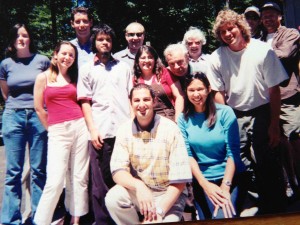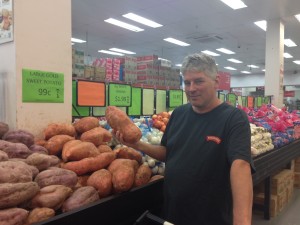Today, I am 53-years-old, been married to Amy for nine years, and it’s my mom’s birthday.
I’ve been looking back, only with an eye to going forward (that’s the lab in Guelph, about early 2005, right; I’ve since been told it was summer 2001; first lesson of professoring — surround yourself with good people).
Three years ago, about this time, I submitted a proposal to my employer, Kansas State University, to take a 20 per cent cut in pay, develop a MOOC in food safety risk analysis (and three other courses), and continue with research and outreach.
I also wrote that “I have promoted K-State and collaborations throughout many countries, particularly New Zealand, Australia, Canada, France, UK, Egypt and Afghanistan. Regarding the latter, I have provided several food safety training sessions for the U.S. military for troops being deployed to that region. Through the bites-l listserv, barfblog.com and media coverage, I have attracted significant attention to the food safety activities at Kansas State University.”
The bosses at Kansas State University determined I had to be on campus, so I was dumped.
Full professors can get dumped for bad attendance.
Like a breakup with someone you really loved, it was messy and takes time, about three years.
But I’m over it.
Irony being ironic, or karma being karma-like, the Manhattan (Kansas) paper re-ran a story today, my birthday and anniversary and my mom’s birthday, from the Topeka paper about my global activities, billing me as a former and retired K-State prof.
I’m not dead yet.
It’s a wonder of the electronic world that journalists from anywhere can find me, but a university that aspires to – something – can’t.
barfblog.com now consists of about 11,580 posts and 60,100 subscribers in over 70 countries. Chapman refers to barfblog.com as a repository of food safety stories.
I like that.
barfblog daily has 4,855 subscribers in over 70 countries.
The barfblog twitter feed has 3,601 subscribers, and Chapman has a bunch more.
 In October, website analytics showed that barfblog.com was visited 573,000 so far in 2015, by 413,000 unique users resulting in over 813,000 page views. This represents a 6% increase in visits, 4% increase in visitors and 6% increase in page views over last year.
In October, website analytics showed that barfblog.com was visited 573,000 so far in 2015, by 413,000 unique users resulting in over 813,000 page views. This represents a 6% increase in visits, 4% increase in visitors and 6% increase in page views over last year.
Chapman also produced and posted 14 Food Safety Talk (www.foodsafetytalk.com) Podcasts during this past year
Food Safety Talk podcasts have been downloaded over 4300 times in the past year (with an average download rate of 340 per episode).
I love what I do, and I love that Amy kicked me out of complacency – nothing would have been easier than to stay at K-State.
And she’s got me playing hockey again, just like she said she would in our self-written wedding vows at City Hall.
In Manhattan (Kansas).
















